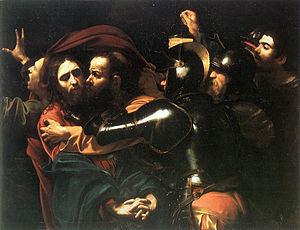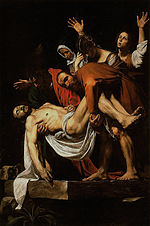Arrest of Jesus

| Events in the |
| Life of Jesus according to the canonical gospels |
|---|
 |
|
Portals: |
The arrest of Jesus is a pivotal event recorded in the canonical gospels. The event ultimately leads, in the Gospel accounts, to Jesus' crucifixion. Jesus was arrested by the Temple guards of the Sanhedrin in the Garden of Gethsemane, shortly after the Last Supper (during which Jesus gave his final sermon), and immediately after the kiss of Judas, which is traditionally said to have been an act of betrayal.
The arrest led immediately to his trial before the Sanhedrin, during which they condemned him to death. In Christian theology, the events from the Last Supper until the crucifixion and resurrection of Jesus are referred to as the Passion.
In the New Testament, all four Gospels conclude with an extended narrative of Jesus' arrest, trial, crucifixion, burial, and resurrection. In each Gospel, these five events in the life of Jesus are treated with more intense detail than any other portion of that Gospel's narrative. Scholars note that the reader receives an almost hour-by-hour account of what is happening.[1]: p.91
Biblical narrative

| Part of a series on |
| Death and Resurrection of Jesus |
|---|
 |
|
Portals: |
According to the canonical gospels, after the Last Supper, Jesus and his disciples went out to Gethsemane, a garden located at the edge of the Kidron Valley, thought by scholars to probably have been an olive grove. Once there, he is described as leaving the group so that he can pray privately.[2][3]
The synoptics state that Jesus asked God that his burden be taken from him, and requested not to need to undergo the events that he was due to, though giving the final choice to God. Luke states that an angel appeared and strengthened Jesus, who then returned to his disciples. The synoptics state that the three disciples that were with Jesus had fallen asleep, and that Jesus criticized them for failing to stay awake even for an hour, suggesting that they pray so that they could avoid temptation.[3]
At that point, Judas gave Jesus a kiss, as a pre-arranged sign to those that had accompanied Judas as to who Jesus was.[3][4] Having been identified, the officers arrested Jesus, although one of Jesus' disciples thought to stop them with a sword, but cut off the ear of one of the arresting officers.[3][4] The Gospel of John specifies that it had been Simon Peter who had cut off the ear of Malchus, the servant of Caiaphas, the high priest.[3][4] Luke adds that Jesus healed the wound. John, Matthew, and Luke state that Jesus criticized the violent act, insisting that they do not resist Jesus' arrest. In Matthew, Jesus made the well known statement "all who live by the sword, shall die by the sword".[3][4]
The account in the Gospel of John differs from that of the synoptics: only in John do Roman soldiers help to carry out the arrest. Judas leads the arresting party to Jesus, but rather than Judas pointing out Jesus, John has Jesus himself, "knowing all that was to happen to him", ask them whom they are looking for; when they say "Jesus of Nazareth", he replies "I am he",[5] at which point all members of the arrest party went backward and fell to the ground.[3][4]
Gallery of art
-
The arrest as depicted in the Book of Kells, c. 800
-
Dieric Bouts, c. 1450-1460
-
The Taking of Christ by Gerard Douffet, c. 1620
See also
Notes
- ^ Powell, Mark A. Introducing the New Testament. Baker Academic, 2009. ISBN 978-0-8010-2868-7
- ^ The Synoptics: Matthew, Mark, Luke by Ján Majerník, Joseph Ponessa, Laurie Watson Manhardt 2005 ISBN 1-931018-31-6 page 169
- ^ a b c d e f g The Bible Knowledge Commentary: New Testament edited by John F. Walvoord, Roy B. Zuck 1983 ISBN 978-0-88207-812-0 pages 83-85
- ^ a b c d e The Bible Knowledge Background Commentary: Matthew-Luke, Volume 1 by Craig A. Evans 2003 ISBN 0-7814-3868-3 page 487-500
- ^ Note, the word "he" is supplied by the translators; the Greek has "I am", the Ego eimi, which explains why the arresting party is stunned. John 18:4
References
- Brown, Raymond E. An Introduction to the New Testament Doubleday 1997 ISBN 0-385-24767-2
- Brown, Raymond E. et al. The New Jerome Biblical Commentary Prentice Hall 1990 ISBN 0-13-614934-0
- Kilgallen, John J. A Brief Commentary on the Gospel of Mark Paulist Press 1989 ISBN 0-8091-3059-9
- Miller, Robert J. Editor The Complete Gospels Polebridge Press 1994 ISBN 0-06-065587-9




